Algorithm Visualizations Report: Impact on Computer Science Learning
VerifiedAdded on 2023/01/04
|5
|1157
|69
Report
AI Summary
This report delves into the significance of algorithm visualizations in computer science education. It highlights that teaching algorithms can be challenging, especially for beginners, and emphasizes the importance of selecting appropriate problems and using clear, problem-oriented languages like pseudocode. The report stresses the cognitive benefits of visualizations, including animations, graphs, and diagrams, in enhancing understanding and engagement. It explores the role of online resources and algorithm visualization tools in facilitating learning and providing opportunities for students to interact with and manipulate algorithms. Furthermore, the report advocates for the adoption of algorithm visualizations to improve teaching methods and student outcomes, suggesting the development of repositories and platforms to support educators and learners. It also references various research papers that support the effectiveness of algorithm visualization in computer science education.
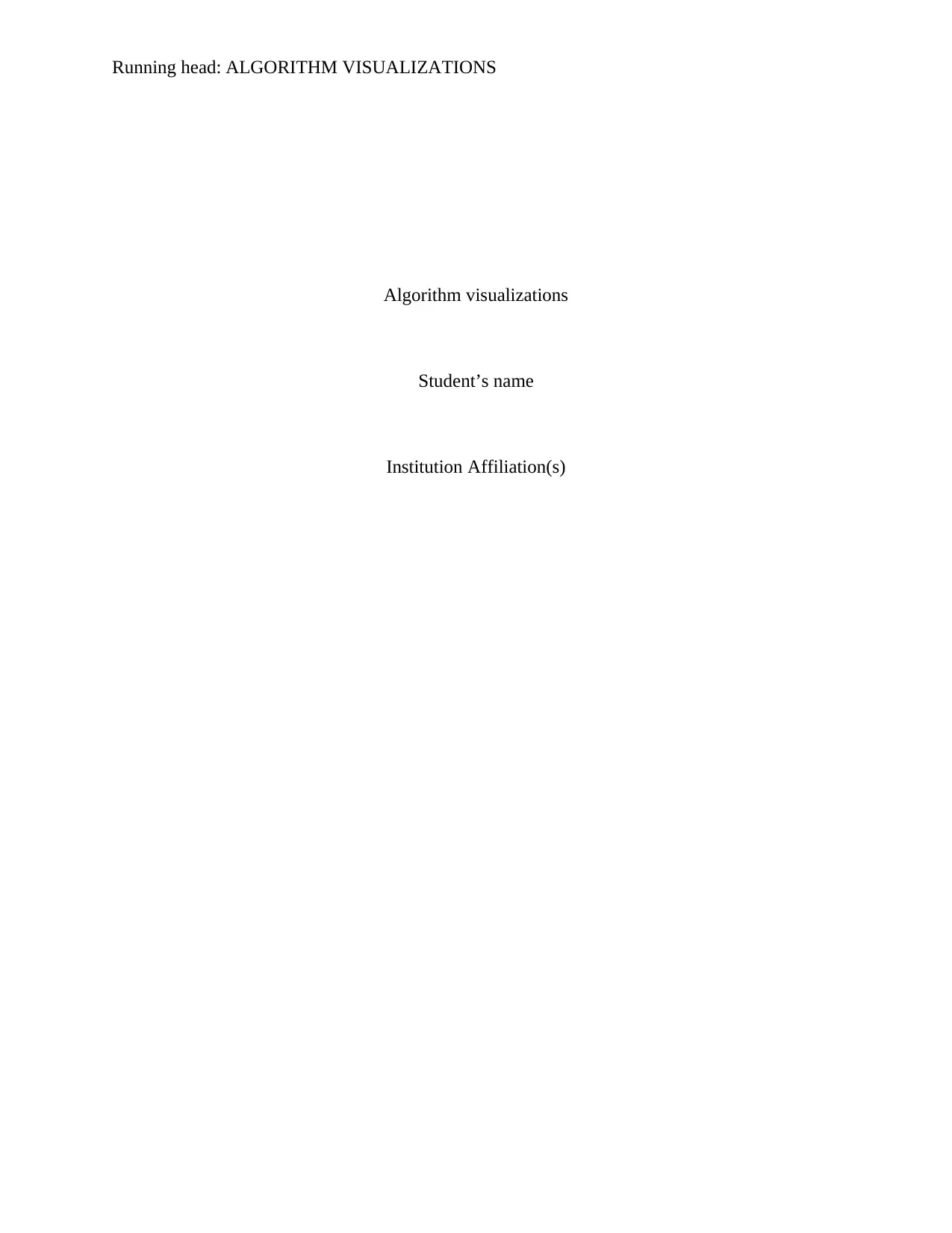
Running head: ALGORITHM VISUALIZATIONS
Algorithm visualizations
Student’s name
Institution Affiliation(s)
Algorithm visualizations
Student’s name
Institution Affiliation(s)
Paraphrase This Document
Need a fresh take? Get an instant paraphrase of this document with our AI Paraphraser
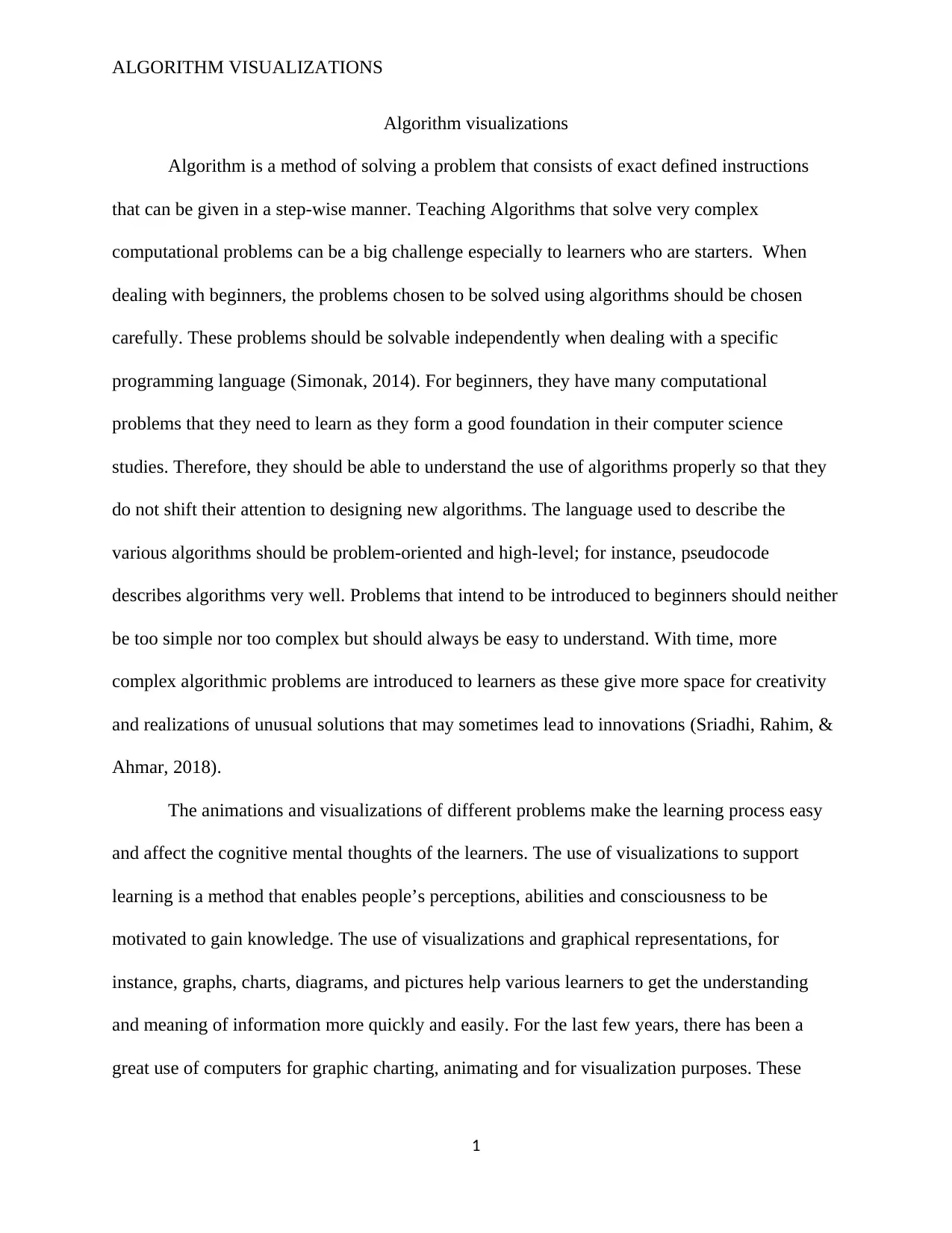
ALGORITHM VISUALIZATIONS
Algorithm visualizations
Algorithm is a method of solving a problem that consists of exact defined instructions
that can be given in a step-wise manner. Teaching Algorithms that solve very complex
computational problems can be a big challenge especially to learners who are starters. When
dealing with beginners, the problems chosen to be solved using algorithms should be chosen
carefully. These problems should be solvable independently when dealing with a specific
programming language (Simonak, 2014). For beginners, they have many computational
problems that they need to learn as they form a good foundation in their computer science
studies. Therefore, they should be able to understand the use of algorithms properly so that they
do not shift their attention to designing new algorithms. The language used to describe the
various algorithms should be problem-oriented and high-level; for instance, pseudocode
describes algorithms very well. Problems that intend to be introduced to beginners should neither
be too simple nor too complex but should always be easy to understand. With time, more
complex algorithmic problems are introduced to learners as these give more space for creativity
and realizations of unusual solutions that may sometimes lead to innovations (Sriadhi, Rahim, &
Ahmar, 2018).
The animations and visualizations of different problems make the learning process easy
and affect the cognitive mental thoughts of the learners. The use of visualizations to support
learning is a method that enables people’s perceptions, abilities and consciousness to be
motivated to gain knowledge. The use of visualizations and graphical representations, for
instance, graphs, charts, diagrams, and pictures help various learners to get the understanding
and meaning of information more quickly and easily. For the last few years, there has been a
great use of computers for graphic charting, animating and for visualization purposes. These
1
Algorithm visualizations
Algorithm is a method of solving a problem that consists of exact defined instructions
that can be given in a step-wise manner. Teaching Algorithms that solve very complex
computational problems can be a big challenge especially to learners who are starters. When
dealing with beginners, the problems chosen to be solved using algorithms should be chosen
carefully. These problems should be solvable independently when dealing with a specific
programming language (Simonak, 2014). For beginners, they have many computational
problems that they need to learn as they form a good foundation in their computer science
studies. Therefore, they should be able to understand the use of algorithms properly so that they
do not shift their attention to designing new algorithms. The language used to describe the
various algorithms should be problem-oriented and high-level; for instance, pseudocode
describes algorithms very well. Problems that intend to be introduced to beginners should neither
be too simple nor too complex but should always be easy to understand. With time, more
complex algorithmic problems are introduced to learners as these give more space for creativity
and realizations of unusual solutions that may sometimes lead to innovations (Sriadhi, Rahim, &
Ahmar, 2018).
The animations and visualizations of different problems make the learning process easy
and affect the cognitive mental thoughts of the learners. The use of visualizations to support
learning is a method that enables people’s perceptions, abilities and consciousness to be
motivated to gain knowledge. The use of visualizations and graphical representations, for
instance, graphs, charts, diagrams, and pictures help various learners to get the understanding
and meaning of information more quickly and easily. For the last few years, there has been a
great use of computers for graphic charting, animating and for visualization purposes. These
1
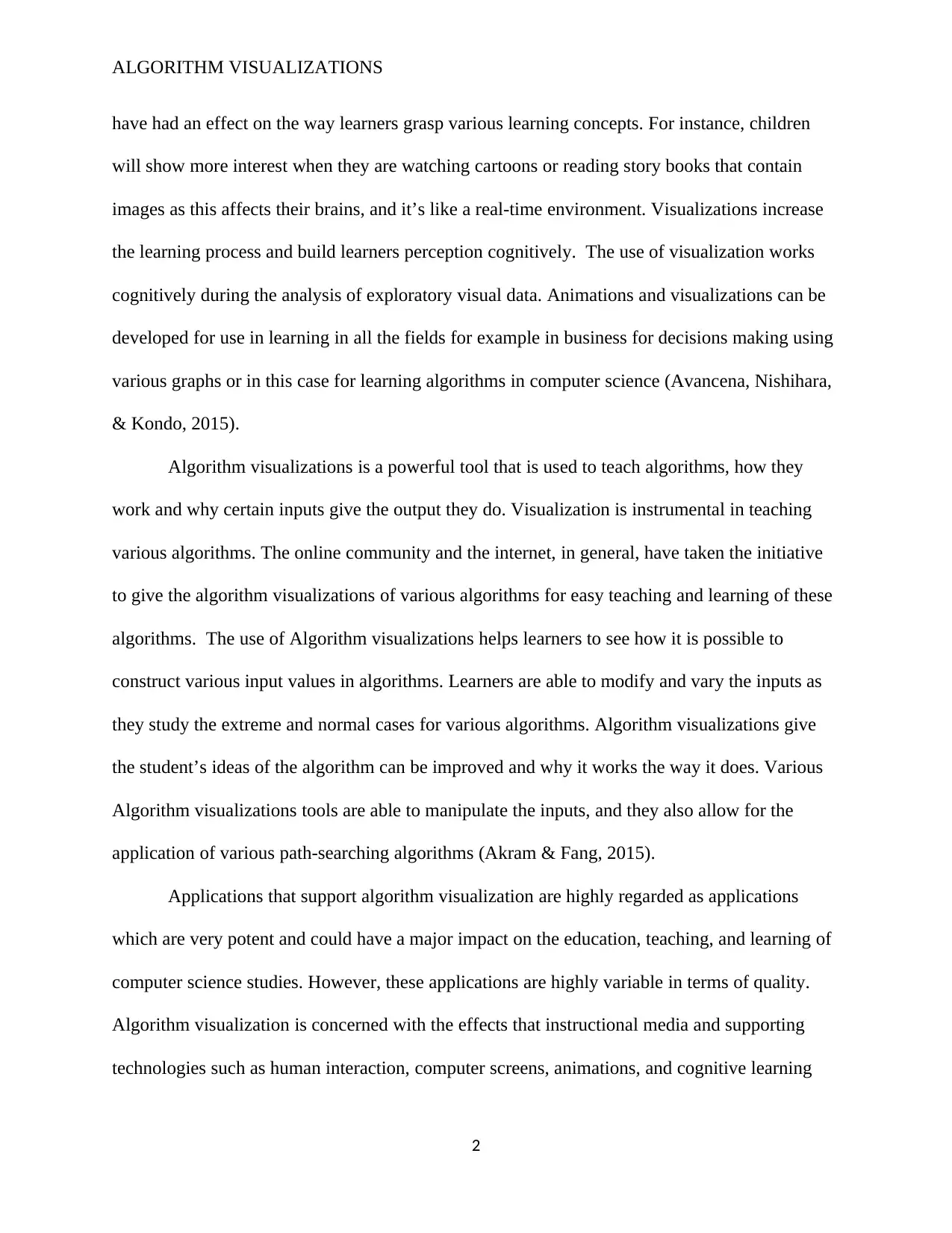
ALGORITHM VISUALIZATIONS
have had an effect on the way learners grasp various learning concepts. For instance, children
will show more interest when they are watching cartoons or reading story books that contain
images as this affects their brains, and it’s like a real-time environment. Visualizations increase
the learning process and build learners perception cognitively. The use of visualization works
cognitively during the analysis of exploratory visual data. Animations and visualizations can be
developed for use in learning in all the fields for example in business for decisions making using
various graphs or in this case for learning algorithms in computer science (Avancena, Nishihara,
& Kondo, 2015).
Algorithm visualizations is a powerful tool that is used to teach algorithms, how they
work and why certain inputs give the output they do. Visualization is instrumental in teaching
various algorithms. The online community and the internet, in general, have taken the initiative
to give the algorithm visualizations of various algorithms for easy teaching and learning of these
algorithms. The use of Algorithm visualizations helps learners to see how it is possible to
construct various input values in algorithms. Learners are able to modify and vary the inputs as
they study the extreme and normal cases for various algorithms. Algorithm visualizations give
the student’s ideas of the algorithm can be improved and why it works the way it does. Various
Algorithm visualizations tools are able to manipulate the inputs, and they also allow for the
application of various path-searching algorithms (Akram & Fang, 2015).
Applications that support algorithm visualization are highly regarded as applications
which are very potent and could have a major impact on the education, teaching, and learning of
computer science studies. However, these applications are highly variable in terms of quality.
Algorithm visualization is concerned with the effects that instructional media and supporting
technologies such as human interaction, computer screens, animations, and cognitive learning
2
have had an effect on the way learners grasp various learning concepts. For instance, children
will show more interest when they are watching cartoons or reading story books that contain
images as this affects their brains, and it’s like a real-time environment. Visualizations increase
the learning process and build learners perception cognitively. The use of visualization works
cognitively during the analysis of exploratory visual data. Animations and visualizations can be
developed for use in learning in all the fields for example in business for decisions making using
various graphs or in this case for learning algorithms in computer science (Avancena, Nishihara,
& Kondo, 2015).
Algorithm visualizations is a powerful tool that is used to teach algorithms, how they
work and why certain inputs give the output they do. Visualization is instrumental in teaching
various algorithms. The online community and the internet, in general, have taken the initiative
to give the algorithm visualizations of various algorithms for easy teaching and learning of these
algorithms. The use of Algorithm visualizations helps learners to see how it is possible to
construct various input values in algorithms. Learners are able to modify and vary the inputs as
they study the extreme and normal cases for various algorithms. Algorithm visualizations give
the student’s ideas of the algorithm can be improved and why it works the way it does. Various
Algorithm visualizations tools are able to manipulate the inputs, and they also allow for the
application of various path-searching algorithms (Akram & Fang, 2015).
Applications that support algorithm visualization are highly regarded as applications
which are very potent and could have a major impact on the education, teaching, and learning of
computer science studies. However, these applications are highly variable in terms of quality.
Algorithm visualization is concerned with the effects that instructional media and supporting
technologies such as human interaction, computer screens, animations, and cognitive learning
2
⊘ This is a preview!⊘
Do you want full access?
Subscribe today to unlock all pages.

Trusted by 1+ million students worldwide
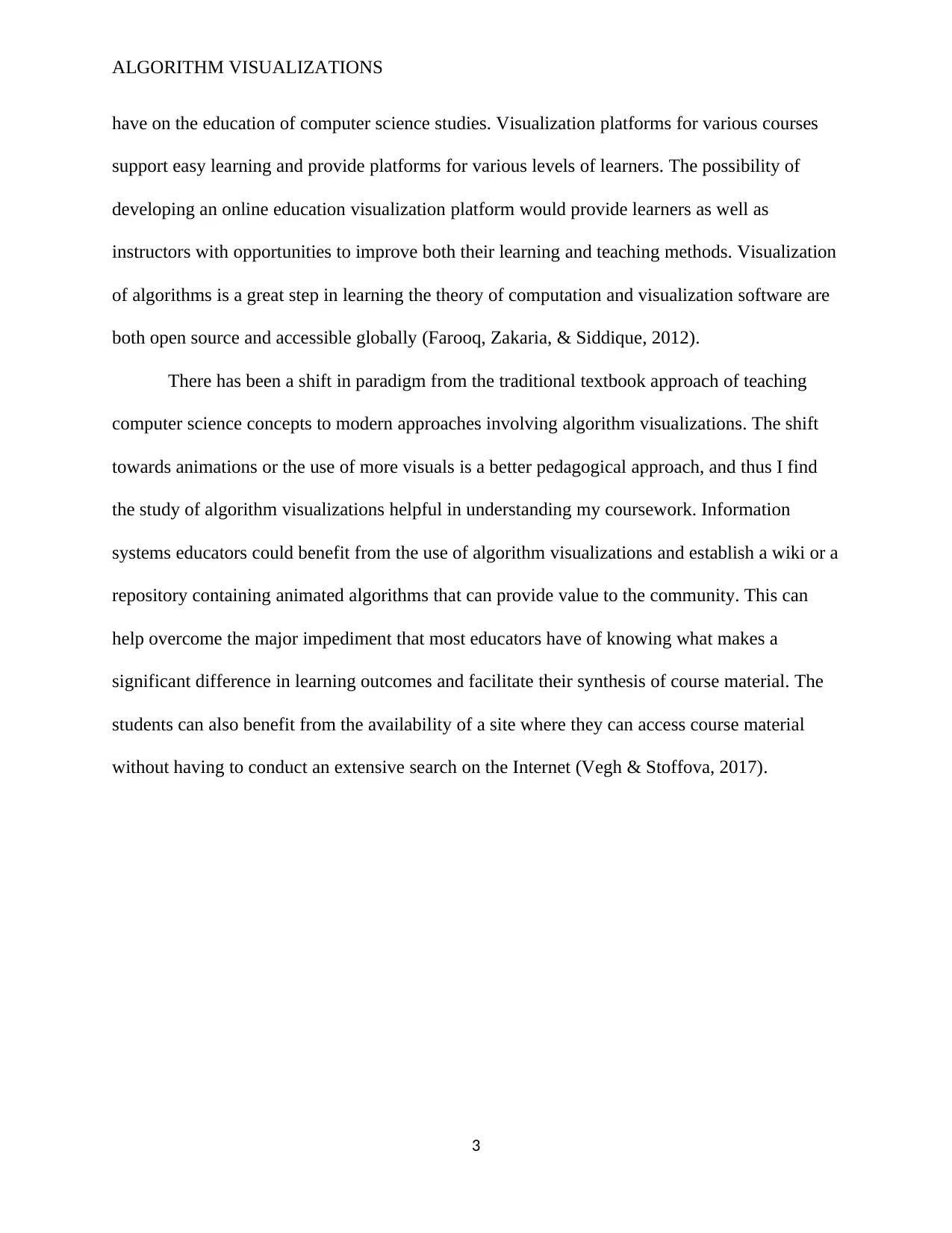
ALGORITHM VISUALIZATIONS
have on the education of computer science studies. Visualization platforms for various courses
support easy learning and provide platforms for various levels of learners. The possibility of
developing an online education visualization platform would provide learners as well as
instructors with opportunities to improve both their learning and teaching methods. Visualization
of algorithms is a great step in learning the theory of computation and visualization software are
both open source and accessible globally (Farooq, Zakaria, & Siddique, 2012).
There has been a shift in paradigm from the traditional textbook approach of teaching
computer science concepts to modern approaches involving algorithm visualizations. The shift
towards animations or the use of more visuals is a better pedagogical approach, and thus I find
the study of algorithm visualizations helpful in understanding my coursework. Information
systems educators could benefit from the use of algorithm visualizations and establish a wiki or a
repository containing animated algorithms that can provide value to the community. This can
help overcome the major impediment that most educators have of knowing what makes a
significant difference in learning outcomes and facilitate their synthesis of course material. The
students can also benefit from the availability of a site where they can access course material
without having to conduct an extensive search on the Internet (Vegh & Stoffova, 2017).
3
have on the education of computer science studies. Visualization platforms for various courses
support easy learning and provide platforms for various levels of learners. The possibility of
developing an online education visualization platform would provide learners as well as
instructors with opportunities to improve both their learning and teaching methods. Visualization
of algorithms is a great step in learning the theory of computation and visualization software are
both open source and accessible globally (Farooq, Zakaria, & Siddique, 2012).
There has been a shift in paradigm from the traditional textbook approach of teaching
computer science concepts to modern approaches involving algorithm visualizations. The shift
towards animations or the use of more visuals is a better pedagogical approach, and thus I find
the study of algorithm visualizations helpful in understanding my coursework. Information
systems educators could benefit from the use of algorithm visualizations and establish a wiki or a
repository containing animated algorithms that can provide value to the community. This can
help overcome the major impediment that most educators have of knowing what makes a
significant difference in learning outcomes and facilitate their synthesis of course material. The
students can also benefit from the availability of a site where they can access course material
without having to conduct an extensive search on the Internet (Vegh & Stoffova, 2017).
3
Paraphrase This Document
Need a fresh take? Get an instant paraphrase of this document with our AI Paraphraser
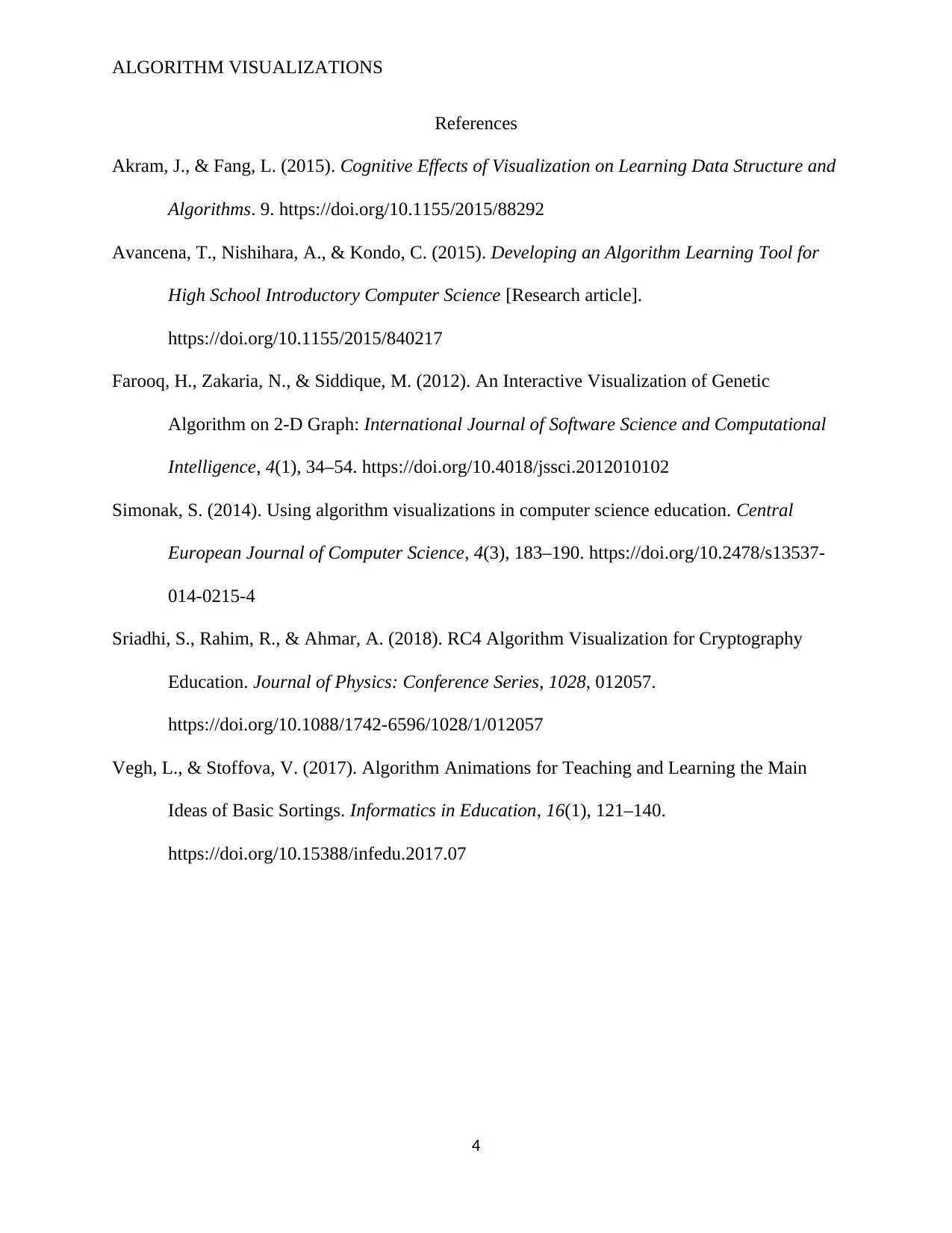
ALGORITHM VISUALIZATIONS
References
Akram, J., & Fang, L. (2015). Cognitive Effects of Visualization on Learning Data Structure and
Algorithms. 9. https://doi.org/10.1155/2015/88292
Avancena, T., Nishihara, A., & Kondo, C. (2015). Developing an Algorithm Learning Tool for
High School Introductory Computer Science [Research article].
https://doi.org/10.1155/2015/840217
Farooq, H., Zakaria, N., & Siddique, M. (2012). An Interactive Visualization of Genetic
Algorithm on 2-D Graph: International Journal of Software Science and Computational
Intelligence, 4(1), 34–54. https://doi.org/10.4018/jssci.2012010102
Simonak, S. (2014). Using algorithm visualizations in computer science education. Central
European Journal of Computer Science, 4(3), 183–190. https://doi.org/10.2478/s13537-
014-0215-4
Sriadhi, S., Rahim, R., & Ahmar, A. (2018). RC4 Algorithm Visualization for Cryptography
Education. Journal of Physics: Conference Series, 1028, 012057.
https://doi.org/10.1088/1742-6596/1028/1/012057
Vegh, L., & Stoffova, V. (2017). Algorithm Animations for Teaching and Learning the Main
Ideas of Basic Sortings. Informatics in Education, 16(1), 121–140.
https://doi.org/10.15388/infedu.2017.07
4
References
Akram, J., & Fang, L. (2015). Cognitive Effects of Visualization on Learning Data Structure and
Algorithms. 9. https://doi.org/10.1155/2015/88292
Avancena, T., Nishihara, A., & Kondo, C. (2015). Developing an Algorithm Learning Tool for
High School Introductory Computer Science [Research article].
https://doi.org/10.1155/2015/840217
Farooq, H., Zakaria, N., & Siddique, M. (2012). An Interactive Visualization of Genetic
Algorithm on 2-D Graph: International Journal of Software Science and Computational
Intelligence, 4(1), 34–54. https://doi.org/10.4018/jssci.2012010102
Simonak, S. (2014). Using algorithm visualizations in computer science education. Central
European Journal of Computer Science, 4(3), 183–190. https://doi.org/10.2478/s13537-
014-0215-4
Sriadhi, S., Rahim, R., & Ahmar, A. (2018). RC4 Algorithm Visualization for Cryptography
Education. Journal of Physics: Conference Series, 1028, 012057.
https://doi.org/10.1088/1742-6596/1028/1/012057
Vegh, L., & Stoffova, V. (2017). Algorithm Animations for Teaching and Learning the Main
Ideas of Basic Sortings. Informatics in Education, 16(1), 121–140.
https://doi.org/10.15388/infedu.2017.07
4
1 out of 5
Related Documents
Your All-in-One AI-Powered Toolkit for Academic Success.
+13062052269
info@desklib.com
Available 24*7 on WhatsApp / Email
![[object Object]](/_next/static/media/star-bottom.7253800d.svg)
Unlock your academic potential
Copyright © 2020–2025 A2Z Services. All Rights Reserved. Developed and managed by ZUCOL.




